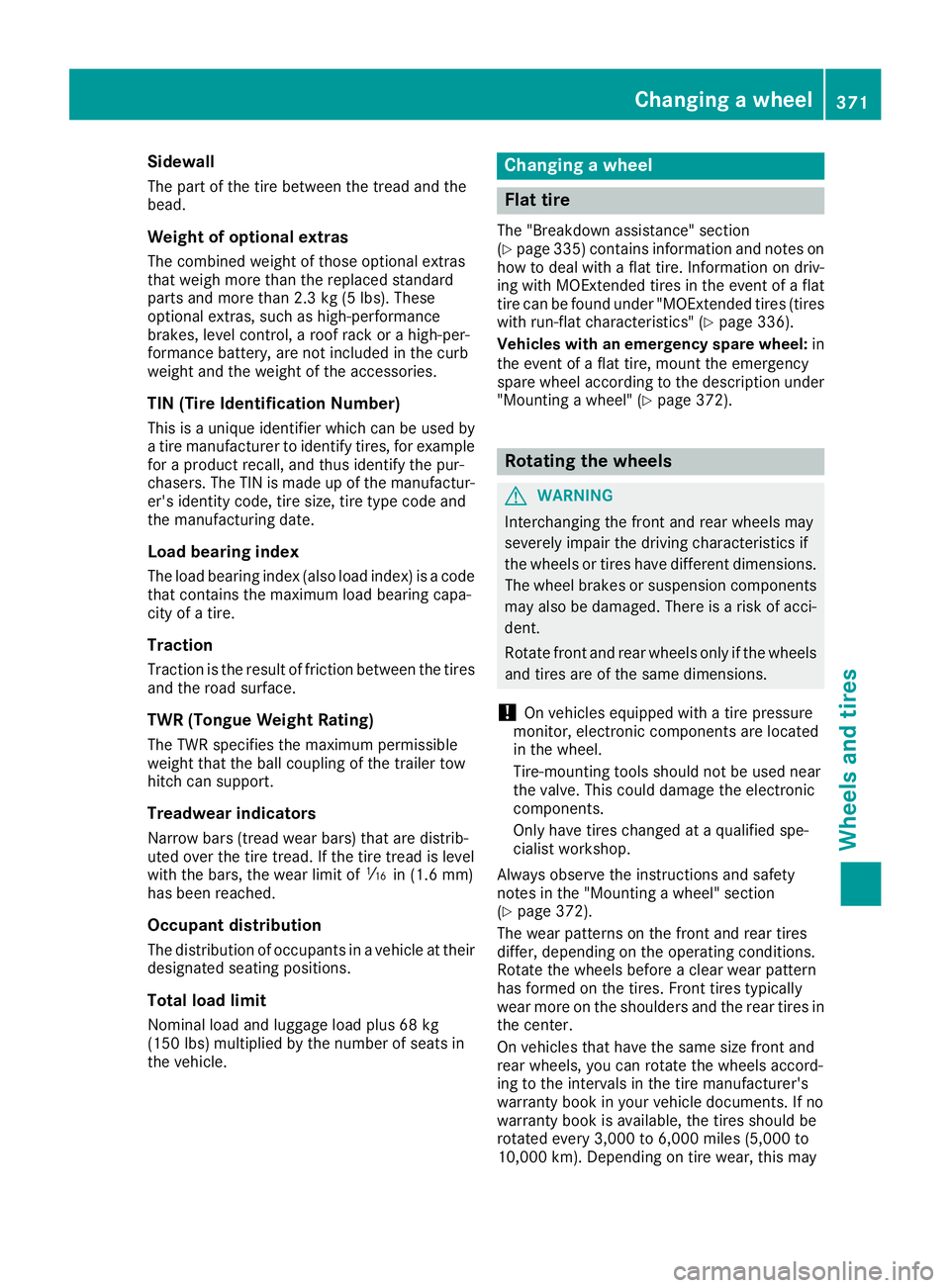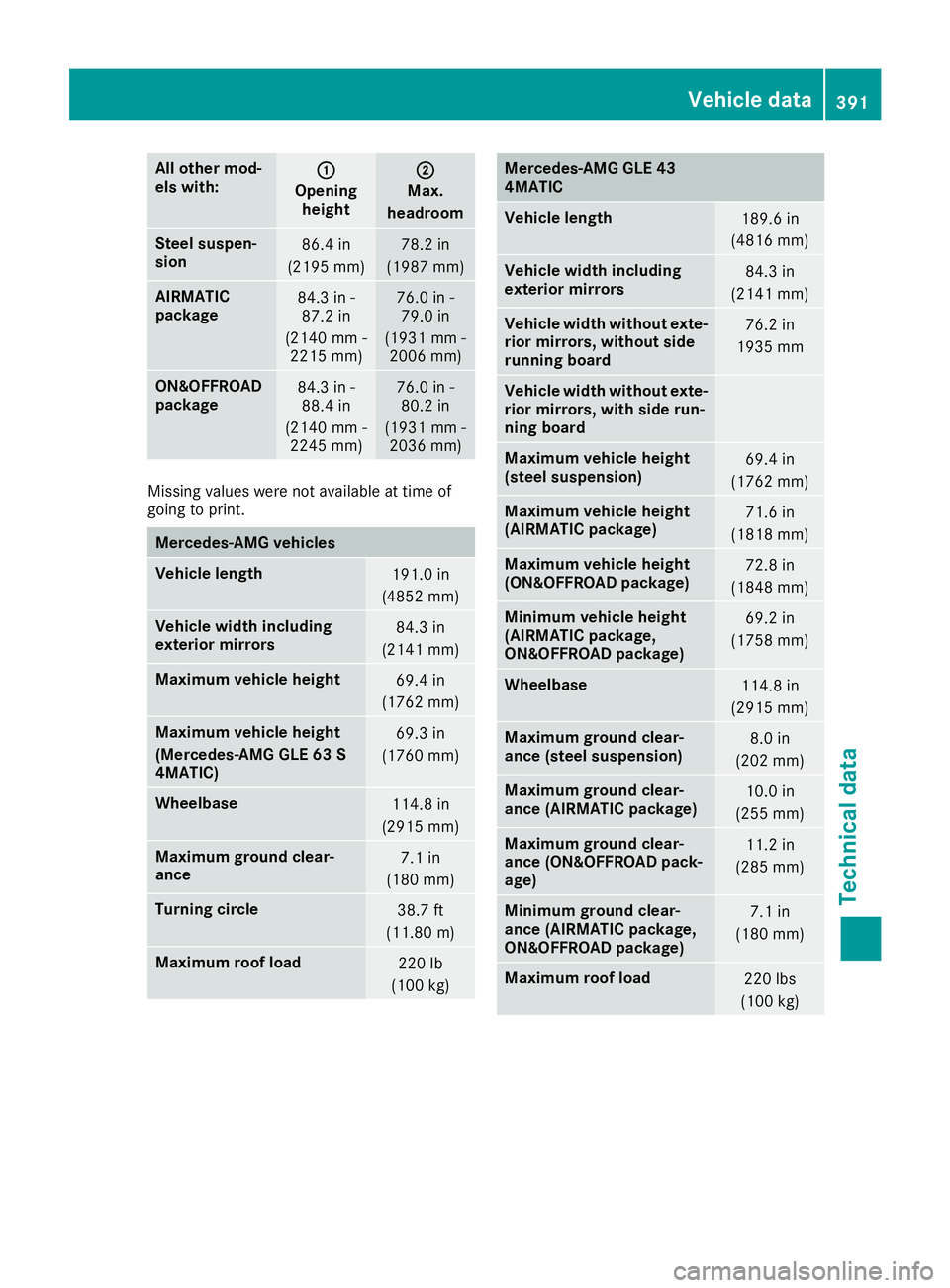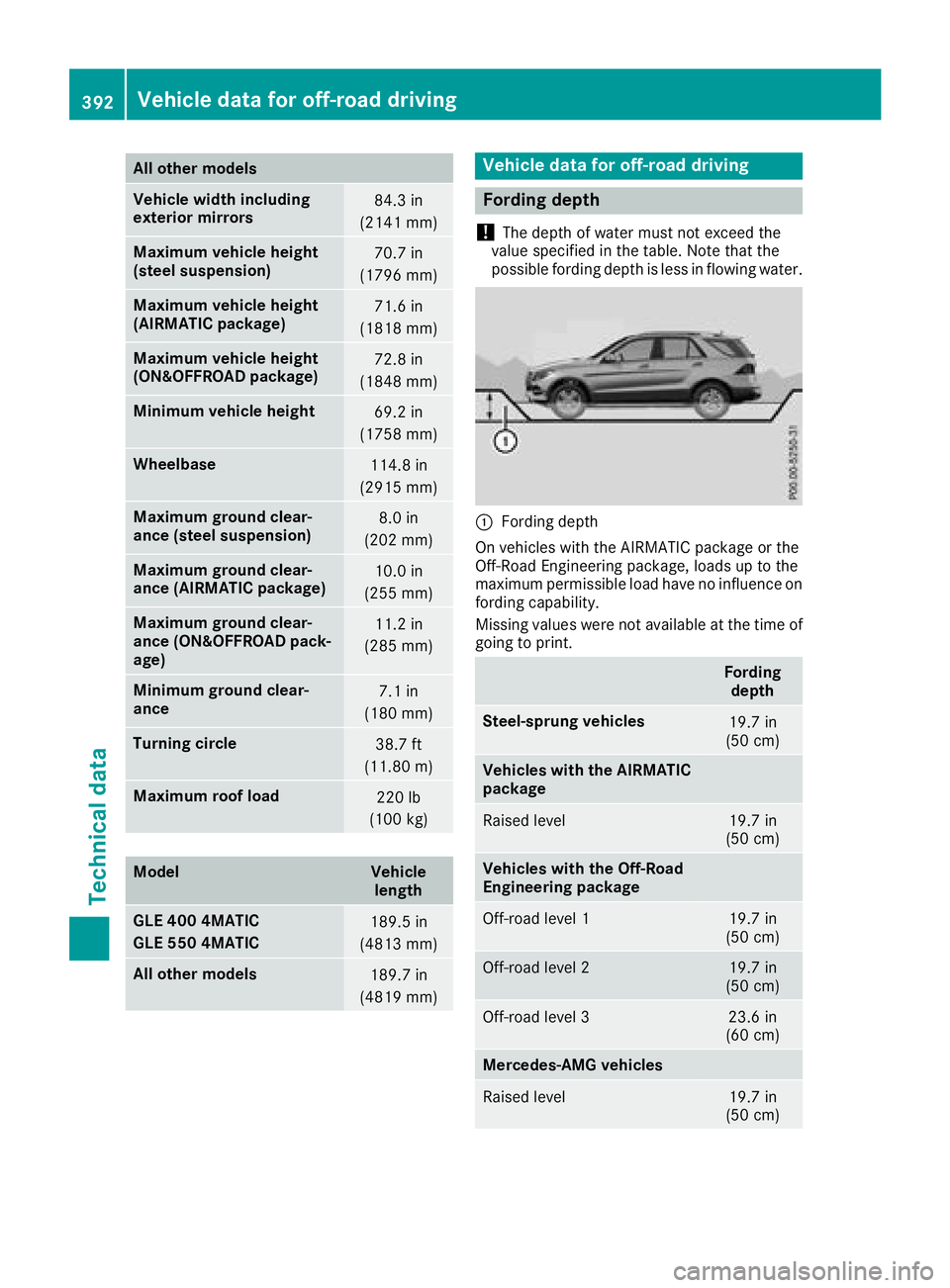Page 373 of 398

Sidewall
The part of the tire between the tread and the
bead.
Weight of optional extras
The combined weight of those optional extras
that weigh more than the replaced standard
parts and more than 2.3 kg (5 lbs). These
optional extras, such as high-performance
brakes, level control, a roof rack or a high-per-
formance battery, are not included in the curb
weight and the weight of the accessories.
TIN (Tire Identification Number)
This is a unique identifier which can be used by
a tire manufacturer to identify tires, for example
for a product recall, and thus identify the pur-
chasers. The TIN is made up of the manufactur-
er's identity code, tire size, tire type code and
the manufacturing date.
Load bearing index
The load bearing index (also load index) is a code
that contains the maximum load bearing capa-
city of a tire.
Traction
Traction is the result of friction between the tires
and the road surface.
TWR (Tongue Weight Rating)
The TWR specifies the maximum permissible
weight that the ball coupling of the trailer tow
hitch can support.
Treadwear indicators
Narrow bars (tread wear bars) that are distrib-
uted over the tire tread. If the tire tread is level
with the bars, the wear limit ofáin (1.6 mm)
has been reached.
Occupant distribution
The distribution of occupants in a vehicle at their
designated seating positions.
Total load limit
Nominal load and luggage load plus 68 kg
(150 lbs) multiplied by the number of seats in
the vehicle.
Changing a wheel
Flat tire
The "Breakdown assistance" section
(Ypage 335) contains information and notes on
how to deal with a flat tire. Information on driv-
ing with MOExtended tires in the event of a flat
tire can be found under "MOExtended tires (tires
with run-flat characteristics" (
Ypage 336).
Vehicles with an emergency spare wheel: in
the event of a flat tire, mount the emergency
spare wheel according to the description under "Mounting a wheel" (
Ypage 372).
Rotating the wheels
GWARNING
Interchanging the front and rear wheels may
severely impair the driving characteristics if
the wheels or tires have different dimensions. The wheel brakes or suspension components
may also be damaged. There is a risk of acci-
dent.
Rotate front and rear wheels only if the wheels and tires are of the same dimensions.
!On vehicles equipped with a tire pressure
monitor, electronic components are located
in the wheel.
Tire-mounting tools should not be used near
the valve. This could damage the electronic
components.
Only have tires changed at a qualified spe-
cialist workshop.
Always observe the instructions and safety
notes in the "Mounting a wheel" section
(
Ypage 372).
The wear patterns on the front and rear tires
differ, depending on the operating conditions.
Rotate the wheels before a clear wear pattern
has formed on the tires. Front tires typically
wear more on the shoulders and the rear tires in
the center.
On vehicles that have the same size front and
rear wheels, you can rotate the wheels accord-
ing to the intervals in the tire manufacturer's
warranty book in your vehicle documents. If no
warranty book is available, the tires should be
rotated every 3,000 to 6,000 miles (5,000 to
10,000 km). Depending on tire wear, this may
Changing a wheel371
Wheels and tires
Z
Page 392 of 398

R-134arefrigerant. Otherwise, th eclimat e
control system may be damaged.
Service work, suc has refillin gwit hrefrigeran tor
replacing component parts, may only be carrie d
out by aqualified specialist workshop. All appli-
cable regulations, as well as SA Estandard J639,
mus tbe adhered to .
Always hav ewor kon th eclimat econtrol system
carrie dout at aqualified specialist workshop.
Refrigerant instruction label
Example: refrigeran tinstruction label
:
Warning symbol
;Refrigerant filling capacit y
=Applicable standards
?PAGoil part number
AType of refrigeran t
Warning symbol :advises you about :
RPossibledanger s
RHaving servic ewor kcarrie dout at aqualified
specialist workshop
Filling capacities
RefrigerantCapacit y
All models37.0±0. 4oz
(1050 ±10 g)
PAG oilCapacity
All models3.9 ± 0.4 oz
(110 ± 10 g)
Vehicle data
General notes
Please note that for the specified vehicle data:
Rthe heights specified may vary as a result of:
-tires
-load
-condition of the suspension
-optional equipment
Roptional equipment reduces the maximum
payload
Observe the information relating to level con-
trol:
RAIRMATIC package (Ypage 185)
ROffroad Engineering package (Ypage 215)
Dimensions and weights
Model:
Opening height
;
Max.
headroom
Mercedes‑AM
G vehicles85 in
2157 mm - 2159 mm76.8 in
1949 mm - 1950 mm
390Vehicle data
Technical data
Page 393 of 398

All othermod-
els with::
Opening height
;
Max.
headr oom
Steel suspen-
sion86.4in
(2195 mm )78.2 in
(1987 mm )
AIRMATIC
package84.3in-
87.2 in
(2140 mm -
2215 mm )76.0 in-
79.0 in
(1931 mm -
2006 mm )
ON&OFFROAD
package84.3 in - 88.4 in
(2140 mm -
2245 mm )76.0 in-
80.2 in
(1931 mm -
2036 mm )
Missingvalues were not available at time of
going to print.
Mercedes ‑AMG vehicles
Vehicle length191.0 in
(4852 mm)
Vehicle width including
exterior mirrors84.3 in
(2141 mm)
Maximum vehicle height69.4 in
(1762 mm)
Maximum vehicle height
(Mercedes-AMG GLE 63 S
4MATIC)69.3 in
(1760 mm)
Wheelbase114.8 in
(2915 mm)
Maximum ground clear-
ance7.1 in
(180 mm)
Turning circle38.7 ft
(11.80 m)
Maximum roof load220 lb
(100 kg)
Mercedes-AMG GLE 43
4MATIC
Vehicle length189.6 in
(4816 mm)
Vehicle width including
exterior mirrors84.3 in
(2141 mm)
Vehicle width without exte-
rior mirrors, without side
running board76.2 in
1935 mm
Vehicle width without exte-
rior mirrors, with side run-
ning board
Maximum vehicle height
(steel suspension)69.4 in
(1762 mm)
Maximum vehicle height
(AIRMATIC package)71.6 in
(1818 mm)
Maximum vehicle height
(ON&OFFROAD package)72.8 in
(1848 mm)
Minimum vehicle height
(AIRMATIC package,
ON&OFFROAD package)69.2 in
(1758 mm)
Wheelbase114.8 in
(2915 mm)
Maximum ground clear-
ance (steel suspension)8.0 in
(202 mm)
Maximum ground clear-
ance (AIRMATIC package)10.0 in
(255 mm)
Maximum ground clear-
ance (ON&OFFROAD pack-
age)11.2 in
(285 mm)
Minimum ground clear-
ance (AIRMATIC package,
ON&OFFROAD package)7.1 in
(180 mm)
Maximum roof load220 lbs
(100 kg)
Vehicle data391
Technical data
Z
Page 394 of 398

All othermodels
Vehicle width including
exteri ormir rors84.3 in
(2141 mm)
Maximum vehicle height
(steel suspension)70.7 in
(1796 mm)
Maximum vehicle height
(AIRM ATICpackage)71.6in
(1818 mm)
Maximum vehicle height
(ON&OFFROAD package)72.8 in
(1848 mm)
Mini mum vehicle height69.2 in
(1758 mm)
Wh eelbase114.8 in
(2915 mm)
Maximum ground clear-
ance (steel suspension)8.0 in
(202 mm)
Maximum ground clear-
ance (AIRM ATICpackage)10.0in
(255 mm)
Maximum ground clear-
ance (ON&OFFROAD pack-
age)11.2 in
(285 mm)
Mini mum ground clear-
ance7.1 in
(180 mm)
Tu rning circle38.7 ft
(11.80 m)
Maximum roofload220lb
(100 kg)
ModelVehicle length
GLE 400 4MATIC
GLE 550 4MATIC189.5 in
(4813 mm)
All other models189.7 in
(4819 mm)
Vehicle data for off-road driving
Fording depth
!
The depth of water must not exceed the
value specified in the table. Note that the
possible fording depth isless in flowing water.
:Fording depth
On vehicles with the AIRMATIC package or the
Off-Road Engineering package, loads up to the
maximum permissible load have no influence on
fording capab ility.
Missing values were not availab leat the time of
going to print.
Ford ing
depth
Steel-sprung vehicles19 .7in
(50 cm)
Vehicles with theAIRMATIC
package
Raised level19 .7in
(50 cm)
Vehicles with the Off-Road
Engineeri ngpackage
Off-road level 119.7in
(50 cm)
Off-road level 219 .7in
(50 cm)
Off-road level 323 .6in
(60 cm)
Mercedes-AMG vehicles
Raised level19 .7in
(50 cm)
392Vehicle data for off-road driving
Technical data